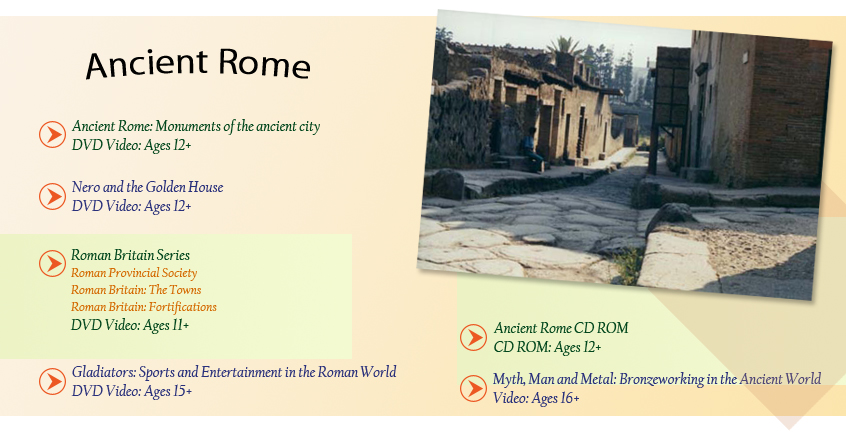|
ROMAN BRITAIN SERIES
Code V17: (DVD ONLY)
- Produced >20 years ago
- Suitable for ages 11-16
This DVD contains 3 programs
- Roman Provincial Society (25 minutes)
- Roman Britain: The Towns (15 minutes)
- Roman Britain: Fortifications (14 minutes)
Program 1
ROMAN PROVINCIAL SOCIETY
This video, presented by Magnus Magnusson, uses archaeological sites, reconstructions and actors to illustrate Roman provincial life - primarily in Roman Britain.
The Roman palace at Fishbourne, Chedworth villa, Bignor Villa and the Roman town of Verulamium are the principal sites investigated and there are brief excursions to Bath, Cirencester, northern France, Pompeii, Herculaneum and Numidia in north Africa.
The information in this video is clearly presented and focuses on the everyday life of Romans living and working in the provinces of the empire.
Program 2
ROMAN BRITAIN: THE TOWNS
When the Romans invaded Britain in the early first century AD, many things were introduced to the island for the very first time. One major change was the development of urban centres in Britain; a land which had formerly seen the existence of nothing larger than a village.
This video uses the site of Verulamium, present day St Albans, as an example of what a Roman town in Britain would have been like. It begins by examining common features of a Roman house including the method of heating and the house's decoration, before looking at the overall layout of these towns with their walls, gates, central forum and other features such as open-air theatres. The road system that linked the various Roman urban centres together is also shown, along with other famous sites such as Roman period Bath. Finally the video examines the people who lived in Roman towns including the everyday objects they once used. A typical Roman family scene is also recreated by actors.
Program 3
ROMAN BRITAIN: FORTIFICATIONS
This program begins by looking at the initial invasion of Britain in the early first century AD and the resistance offered by the local Britons. As a consequence of this resistance, and the threat of further revolts, the Romans had to build a network of roads and forts to secure the island.
The video shows how these forts were built to a similar design with room for granaries, barracks, stables and houses for the commanding officers. The program then examines the construction and use of Hadrian's Wall in northern England. This piece of engineering, stretching for over 115 km, shows the Romans' determination to keep their southern provinces peaceful. The design of this frontier defence is outlined and students are shown how it would had operated during a conflict. The video ends by looking at the 'Forts of the Saxon Shore'; a series of defences built in eastern England towards the end of the Roman occupation designed to thwart Saxon raiders who were then threatening Britain.
For prices, see our catalogue 
Back to top
|


